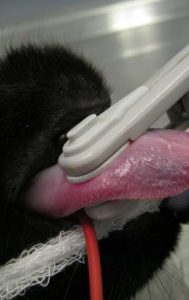Ron Hines DVM PhD


Bleeding Time = Buccal Mucosal Bleeding Time (BMBT) or Toenail Bleeding Time
This simple in-office screening test allows your veterinarian to measure how well your dog or cat’s blood clots (=hemostasis) after an injury, prick or incision. Bleeding time depends on how well your pet’s blood platelets and the complicated clotting mechanism that activates them are functioning. Your veterinarian might be motivated to run this test if your pet is anemic and the cause undetermined, or perhaps if it bled from its nose, ear or eye without an explainable cause, or perhaps because extensive surgery or a liver or kidney biopsy is contemplated. A surgical incision or needle blood withdrawal that did not clot as expected also warrants this or similar tests.
For a wound of any sort to stop bleeding, a “plug” of adhering, sticky blood platelets/thrombocytes must form in the blood vessels supplying that area. To perform the bleeding time test, a prick is made in the inner surface of your dog’s lip and a stop watch is used to measure the period of time it takes before the flow of blood from the wound to cease. Similar tests could be performed on cats – but they rarely are. Cats resent oral manipulations. So, I generally check their blood clotting speed on glass. The chief problems with the bleeding time test are the restraint of your pet during the procedure and variations in what is considered normal due to differing techniques and differing oral capillary vascularity. A similar test times how long a toenail that has been clipped to the quick, continues to bleed (Cuticle Bleeding Time CBT aka Toenail Bleeding Time TBT). It is quite painful to have that done to your pet. Don’t allow it.
What Might Cause My Dog Or Cat’s Bleeding Time To Be Abnormally Long?
A dog’s bleeding time can be extended when it has received NSAIDs (such as aspirin, Rimadyl®, Deramaxx®, Previcox®, Metacam® etc.). That is particularly true with large doses. It is also a danger if your dog has other health issues that might delay its blood coagulation or if it was born with genetic bleeding tendencies (such as mild von Willebrand disease [vWD]). Cats never handle NSAIDs well. However, in cats, it is their kidneys, not their thrombocytes, that are most likely to be affected. At best, a single NSAID injection just prior to surgery or shortly after is permissible. (read here)
Bleeding time is sometimes increased in disseminated intravascular coagulation (= DIC, a shock-like condition). However, the effects of DIC on bleeding time is inconsistent.
Bleeding time can also be increased in liver failure. That is because your pet’s liver produces many clotting factors essential for blood coagulation. (read here)
Bleeding time also increases in a specialized form of liver disease called portosystemic shunts. (read here) Read in length about portosystemic shunts in pets here.
A similar situation of slowed blood clotting can occur in dogs and cats whose kidneys are failing. At that stage, they are azotemic (uremic) due to their advanced kidney disease. with high levels of uremic toxins in their bloodstream. Those toxins inhibit the ability of thrombocytes to clump and form clots. (read here)
Occasionally, dogs and cats with congestive heart disease develop bleeding tendencies as well. That is thought to be due to insufficient oxygen delivered to their liver, the source of many essential blood coagulation factors. (read here)
Blood clotting can also be delayed in dogs infected with Leishmania, Ehrlichia or Anaplasma (Wikipedia is mistaken, it also occurs in dogs).
Cat that carry the feline leukemia virus often have low thrombocyte counts and therefore longer blood clotting times. That does not appear to be the case with cats that carry the feline immunodeficiency virus (FIV). (read here)
Diseases that involve your pet’s bone marrow (myeloproliferative disorders) can also be responsible for slower than normal clotting times – as will any other illness that causes low thrombocyte (= blood platelet) numbers. Thrombocytes begin their lives in your pet’s bone marrow.
Some uncommon inherited disorders can cause extended bleeding times too. They include defective blood platelets that are occasionally seen in otter hounds and Great Pyrenees dogs (Glanzmann’s thrombasthenia) and platelet defects in spitz, basset hounds and American cocker spaniels. Inherited Chediak-Higashi syndrome, when it affects Persian cats that have a smoke-blue hair coat, can also responsible for increased bleeding time.
The administration of emergency blood substitutes (e.g. dextran70) can also caused delayed blood clotting. Administering large amounts of IV fluids can have the same effect. (read here)
Accidental consumption of certain rodent poisons (such as those containing diphacinone) also increase bleeding time.
Complementary tests:
A complete blood clotting panel, Liver Function Panel, liver biopsy, Tests to detect exposure to anticoagulant rodent poisons
DxMe
You are on the Vetspace animal health website
Visiting the products that you see displayed on this website help pay the cost of keeping these articles on the Internet.


